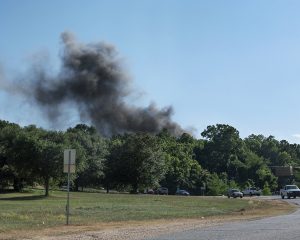Assistant Professor Allison Grant is part of a joint project awarded funding support by the Collaborative Arts Research Initiative (CARI), Alabama Life Research Institute, and Office of Research and Economic Development. The project’s review panel called the collaborative work “both timely and significant.”
The project, titled “Dangerous Landscapes: Legacies of Nineteenth-Century Progress in the Age of Climate Change,” is a Joint Pilot for Arts Research Grant project with Grant, Dr. Teresa Cribelli, associate professor of history and principal investigator, and Dr. Joan Barth of UA’s Institute for Social Science Research.

The collaborators plan to install an exhibition in 2021 that places Grant’s contemporary environmental photographs alongside illustrations of the American landscape from nineteenth-century print culture collected by Cribelli in her historical research on narratives of progress. Accompanying the exhibition will be historical analysis by Cribelli. Assessments of the impact of the visual images on the public will be conducted by Barth. The co-investigators will develop an accompanying website and print materials.
Nineteenth-century images depicting the endless frontier of the American landscape coexisting in a romanticized, benign relationship with the burgeoning industrial culture appeared frequently in newspapers, pamphlets, and other print publications. The reality is much more ominous. The co-investigators write, “Nineteenth-century progress has left a darker legacy that is readily visible in the Alabama landscape. Carbon emissions and toxic residue from the combustion engines that trucked people and goods across the globe, and the whirring, coal-fired machines that produced everything from books to bicycles have contributed to the largest environmental challenge of our time: Climate Change.”

In the exhibition, these images of the contributors to global climate change will be juxtaposed with the environmental photography of Allison Grant. Grant’s award-winning photographic work illuminates the beauty and the perils of our contemporary environment to which she and her family – and all humanity – are inextricably tied. Central to Grant’s photographs, taken near her home in west Alabama, the project investigators observed, is that they “bear witness to the chemical and fossil fuel industries that dot the region, which are often situated amid thick greenery in areas just outside of public view.” In contrast, while “the landscapes of the nineteenth century offered a bright pathway to the future, in Ms. Grant’s photographs that future is less certain.”
The project also aims to encourage conversations within Alabama about how climate change will impact the Deep South, a region expected to experience profound climatic shifts. Through the placement of images, the collaborators ask viewers to consider how present-day climate change has resulted from the environmental legacy of nineteenth-century ideas of progress. Before and after the exhibition, the project includes a social science component that studies how critical readings of visual material shape individuals’ perceptions of history and the environment, conducted by Dr. Joan Barth of the Institute for Social Science Research. Barth will administer surveys to classes at UA to assess how the public understands visual depictions of the environment both in historical and contemporary terms.
For more information about The University of Alabama’s programs in studio art and art history, visit our Degree Programs page.